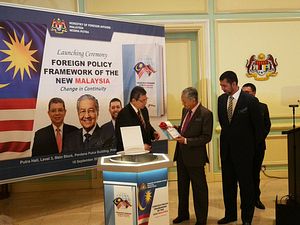Last month, Malaysia’s ruling Pakatan Harapan (PH) government finally released a much-anticipated document articulating its key foreign policy priorities. While the contents of the Foreign Policy Framework (FPF) for a New Malaysia largely reflect what officials had indicated previously, it nonetheless is worthy of close examination as it constitutes the first standalone, comprehensive guide to the Southeast Asian state’s approach to the world since a shock election result last May.
As I have noted before in these pages and elsewhere, while there has been some continuity in Malaysia’s foreign policy over the past five decades with respect to general priorities – including fostering closer bilateral ties with neighboring states, expanding the country’s role in key regional and global fora, and an attempt to maintain equidistance between major powers, including the United States and China – there has also been some change amid that continuity with respect to certain areas of focus, issues, or relationships.
With the PH government coming to power following the shock May election results last year, the key question was the extent of continuity and change we would see in Malaysia’s foreign policy relative to the Najib years. Though there had been attention to a mix of individual developments and issue areas – from reviews of infrastructure projects with China to Malaysia’s approach to the Rohingya crisis to renewed tensions with Singapore – there has still been little clarity on how all of this adds up to an overall approach.
One of the documents that was said to offer some greater clarity on this was what Malaysian officials had been terming the Foreign Policy Framework (FPF). As I noted before in an exploration of the thinking embedded in the document ahead of its release, the FPF was meant as a publicly released foreign policy document that would articulate the PH government’s general foreign policy orientation, building off of previous policy positions and articulations, including Prime Minister Mahathir Mohamad’s address to the UN General Assembly last year.
Earlier this month, the FPF finally had its official launch. The launching ceremony took place at the administrative capital of Putrajaya on September 18 under the banner “Foreign Policy Framework of the New Malaysia: Change in Continuity,” and it was attended by top officials including Mahathir himself, along with other distinguished guests. In addition to the launching ceremony itself, the FPF was also made publicly available as had been previously indicated.
The content of the FPF itself as a document is largely along the lines of what officials had suggested earlier. After an introduction and a brief look at the thinking and goals of the PH administration, the framework is divided into four sections that reflect its key priorities: the overall direction of foreign policy; empowering the foreign ministry; enhancing interagency collaboration; and increasing public and civil society participation. The document delves into these priorities from a variety of perspectives, from more general ones such as South-South cooperation and reforming regional and international organizations, to more specific ones such as the Israel-Palestine issue and the South China Sea.
The FPF’s release is no doubt a significant development. In general, as the first standalone, comprehensive document issued by the PH government since it came to power last May, it transparently lays out its key foreign policy priorities and provides a more concrete foundation behind its thinking to situate the dizzying array of issues and developments that can often dominate the headlines. As Mahathir himself noted in his own remarks at the launch, it is at once a milestone for Malaysia’s foreign policy, a guidepost for the advancement of policy priorities, and a living document for those interested in Malaysia’s evolving approach to the world. More specifically, some of the particular aspects of the FPF in terms of thinking and process, such as integrating a more diverse set of views into foreign policymaking, offer promise in terms of a more consultative and transparent approach to this area.
But as with any formal policy document issued following a major government change, the FPF also leaves several questions unanswered. Some of these relate to how the formal priorities outlined will actually translate into reality given some of the challenges we have already seen during the PH government’s first year in power, be it the initial 10 percent cut in defense spending in the first budget last year or reconciling Mahathir’s personal views and tendencies with that of the broader considerations in Malaysia’s foreign policy. And still others concern the sustainability of the FPF amid upcoming change, be it the leadership transition from Mahathir to Anwar Ibrahim to whether the PH government will get another term following Malaysia’s next general election.
Of course, all that does not detract from the significance of the FPF itself. But it does mean that even as we acknowledge the value of the document, we should also be aware of its limitations in reflecting what we are seeing and may see in the future with respect to the actual evolution of Malaysia’s foreign policy under the PH government in the coming years.
































